CHAPTER 1: MENTAL LANDSCAPES
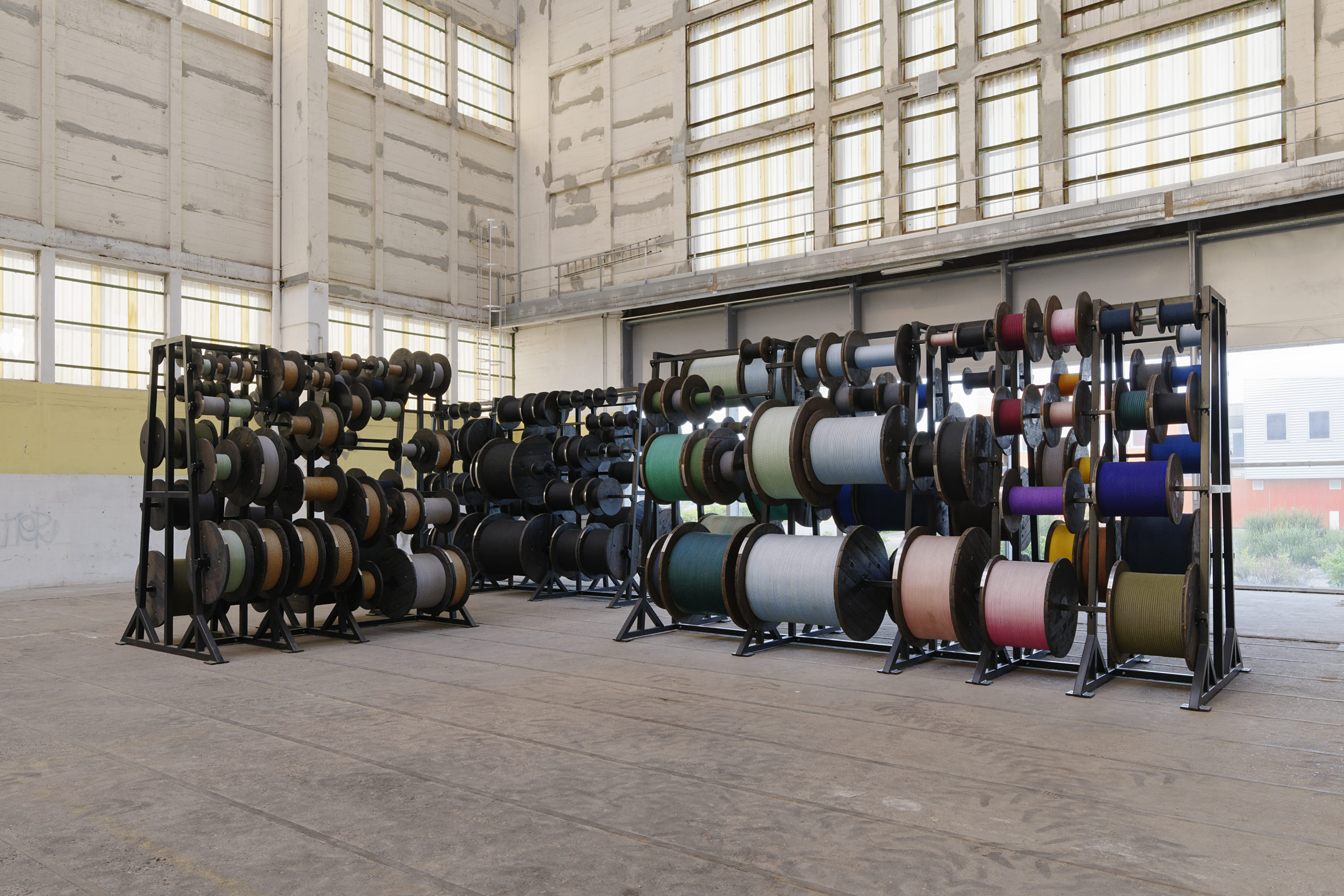
This chapter converges and explores large- and small-scale creations, globalized industry and consumption, spatial perception and functional architecture, heritage and contemporary art… It occupies several sites of the Dunkirk Contemporary Art Hub, with artworks well suited to their chosen exhibition spaces and the area’s industrial, port and seaside landscapes that the public is invited to (re)discover.
Imagined for the municipality’s available locations, the installations draw inspiration from the more or less visible industrial materials, flows, objects and skills belonging to Dunkirk’s unique heritage. A cinematographic horizon formed by the key moments of Europe’s modern post-war history. The artists work with new materials, experiment with new techniques and expertise, escaping the established confines of painting and sculpture. They free themselves of traditional frameworks and settings by collaborating with engineers and companies. They produce works in series, create large or even gigantic works, and occasionally directly invest the landscape.
Emblematic of this industrial activity, the striking Halle AP2 industrial wasteland provides an exceptional setting for presenting the fantastic and phantasmagoric elements of GIGANTISME — ART & INDUSTRIE – in other words, its outsized and exceptional creations. By their size, weight, materials or occupation of space, the works – expressly produced for the occasion or reinstalled in situ – reveal both the structure and its uses. In resonance with the immediate surroundings, the guest artists’ installations dialogue with the architecture of this veritable industrial cathedral, resurrected to host art and highlighted by its twin FRAC edifice designed by the architects Lacaton & Vassal.
(Projects by Angela Bulloch, Carlos Bunga, Anita Molinero, Alexandre Périgot, Delphine Reist, Tatiana Trouvé and Bernar Venet)
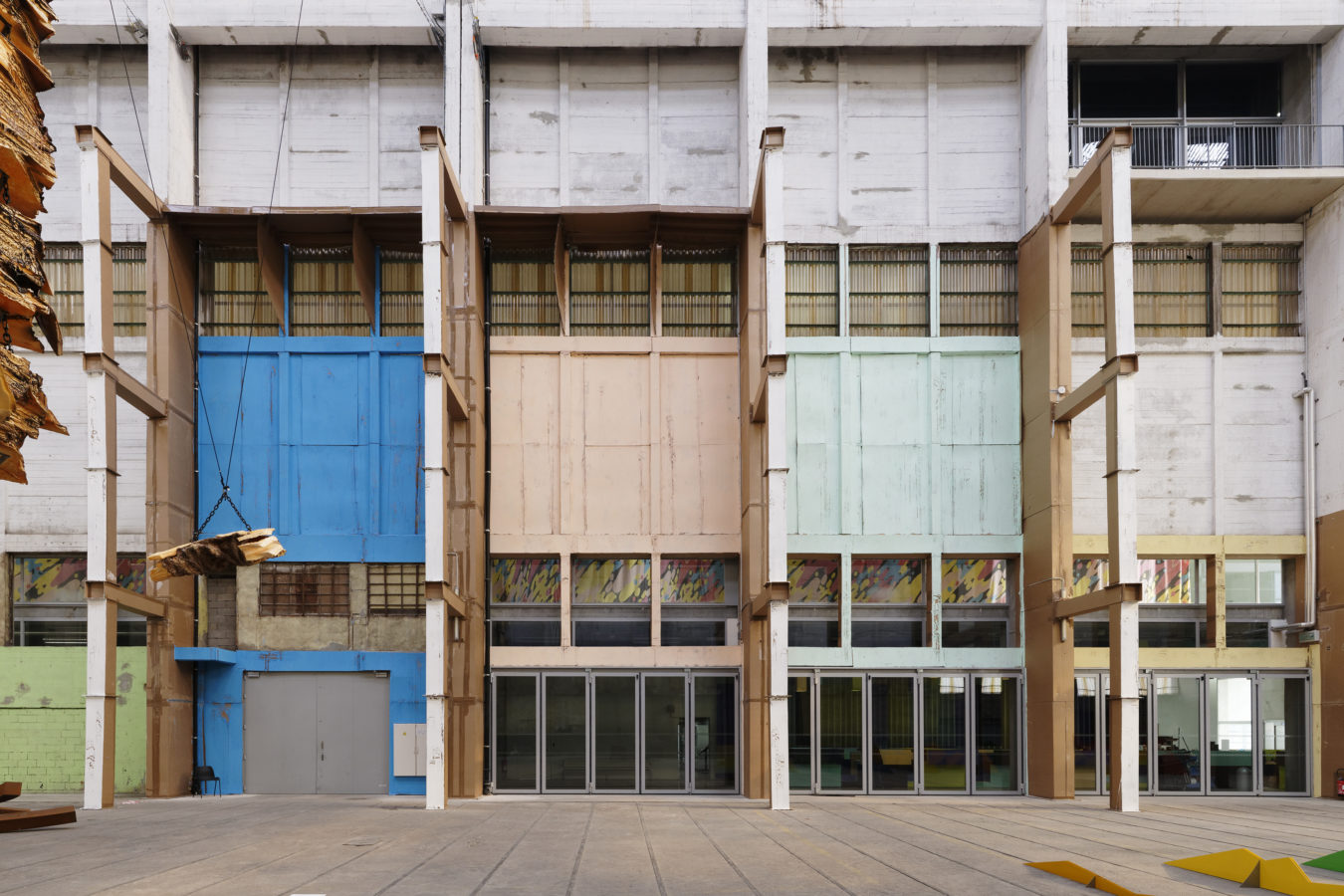
The FRAC’s 5th-floor belvedere offers three perspectives: the port and flare towers of the Dunkirk industrial sites, the city’s dike and sea view, and finally the emerging Contemporary Art Hub comprising the FRAC, the LAAC and the footbridge to the beach. Upon this belvedere, in connection to industry, the presented works evoke seriality, dispersion and dissemination, with an emphasis on their own engineering.
(Works by Robert Breer, Charlotte Posenenske and Takis and flag projects scattered about the marinas and offering mobile perspectives)
In the outdoor spaces, certain projects (sculptures or installations) are created, assembled and installed in collaboration with local businesses, or will soon be the subject of public commissions, in continuity with the sculptures already occupying the LAAC garden.
In the late 1970s, the LAAC’s founder, Gilbert Delaine, first proposed the creation of a garden-museum in the Grand Large district, while much of the site was still occupied by the Chantiers Navals de France shipyards, with the cranes to form the backdrop, thereby allowing for a symbiosis of art, industry and the city. The LAAC pursues this project of integration with this same ambition, today in collaboration with the FRAC occupying the former shipyards site. Guest artists invited to invest the breakwaters, sea canal and marinas perpetuate this artistic link to an ever evolving environment.
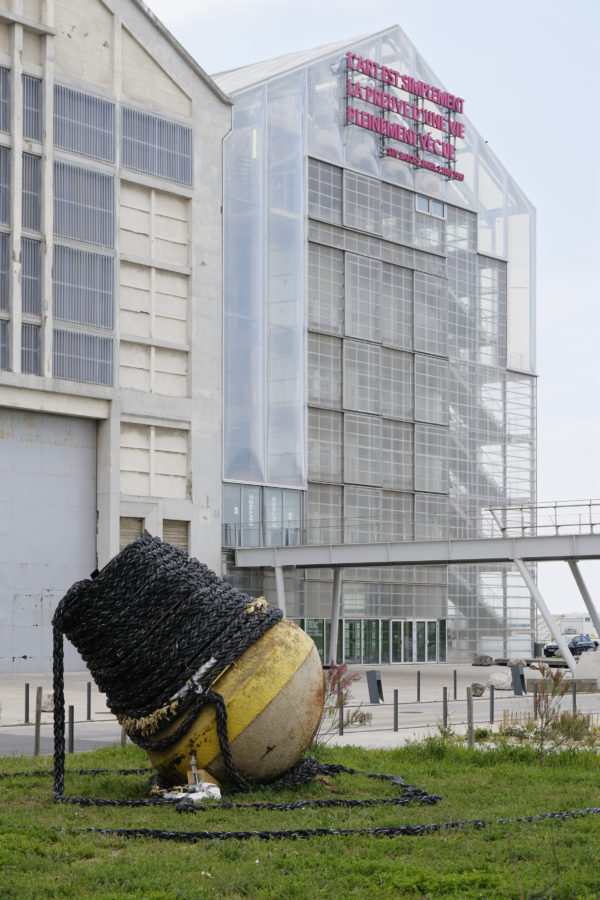
Frac Grand Large — Hauts-de-France, Dunkirk
Certain outdoor exhibitions comprise less tangible works, specifically based upon orality, playing upon forms of storytelling, performance and transmission. The public is invited to pass through and observe each landscape, to feel, test and reconsider it, whether it be an industrial, naval or beach setting. And like so many scattered landmarks or merely suggested strolls, the great variety of viewpoints offer visitors unique opportunities to simultaneously contemplate both the presented works and the surrounding spaces.
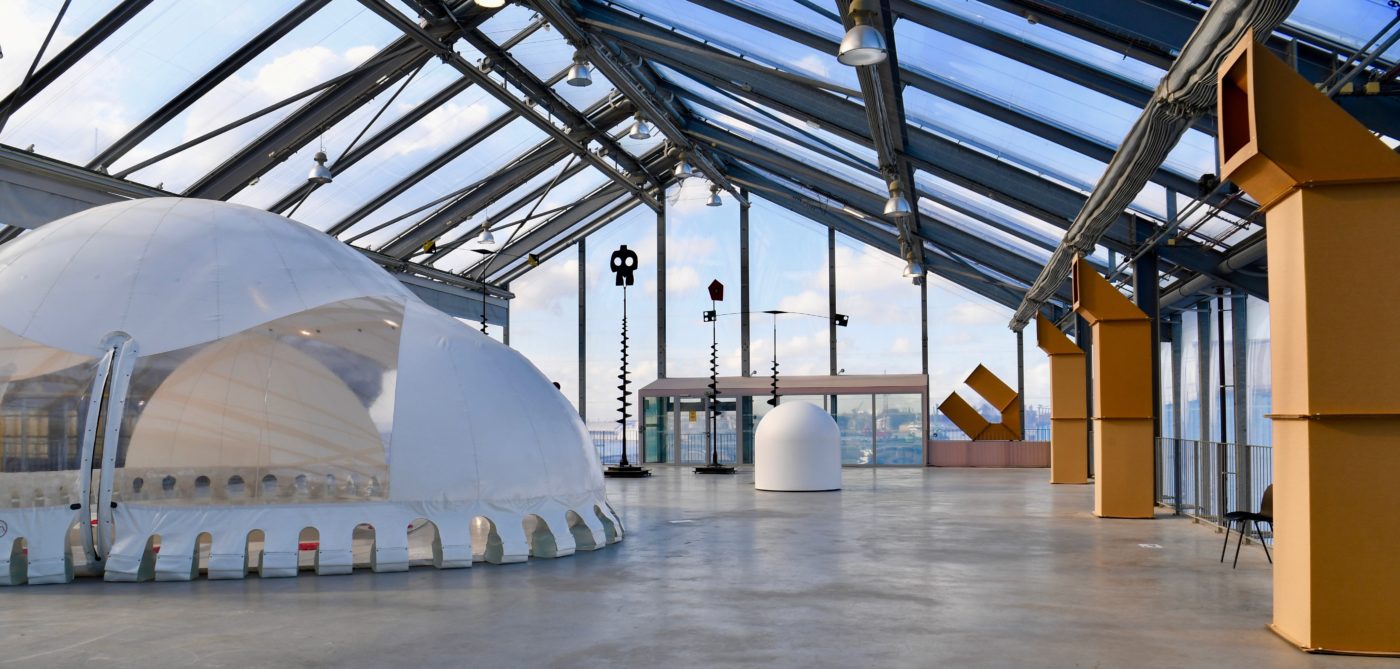
Frac Grand Large — Hauts-de-France, Dunkirk
(Projects for public installations are currently being prepared by Nathalie Brevet_Hughes Rochette, Jean-Daniel Berclaz, Hera Büyüktaşçıyan, Maya Hayuk, Donovan Le Coadou, Tania Mouraud, Matt Mullican and Morgane Tschiember, among others, with further projects focusing on orality by Céline Ahond, Dector & Dupuy, Mark Geffriaud, Dominique Gilliot, Ludovic Linard and Flora Moscovici)
Descriptions of a few works
The French artist Anita Molinero sculpts polyurethane, a type of petrol-based plastic, by melting it, thereby bringing to mind César. An infinitely transformable material, the accumulation of which creates fantastical worlds. The murals and vertiginous vertical arches dialoguing with the mental architecture of both buildings, made from cardboard left unadorned or covered with pastels by the Portuguese artist Carlos Bunga, testify to the ephemeral quality of this material (compared to the more glorious past of coal, steel, petrol and plastic), but also to its persistence due to its indispensability for both global and local trade flows.
The mechanical light installation by the Swiss artist Delphine Reist restores to Halle AP2, in operation from 1947 to 1987, its production facility. The bridge crane is bizarrely activated to remind observers of its original use: moving heavy and huge materials for the assembling of Chantiers de France ships, which previously occupied much of today’s Grand Large district. The artist has seized upon this precursor of computerized manufacturing, to highlight the progressive industrialization of our private lives via the explosion of post-Fordism machinery.
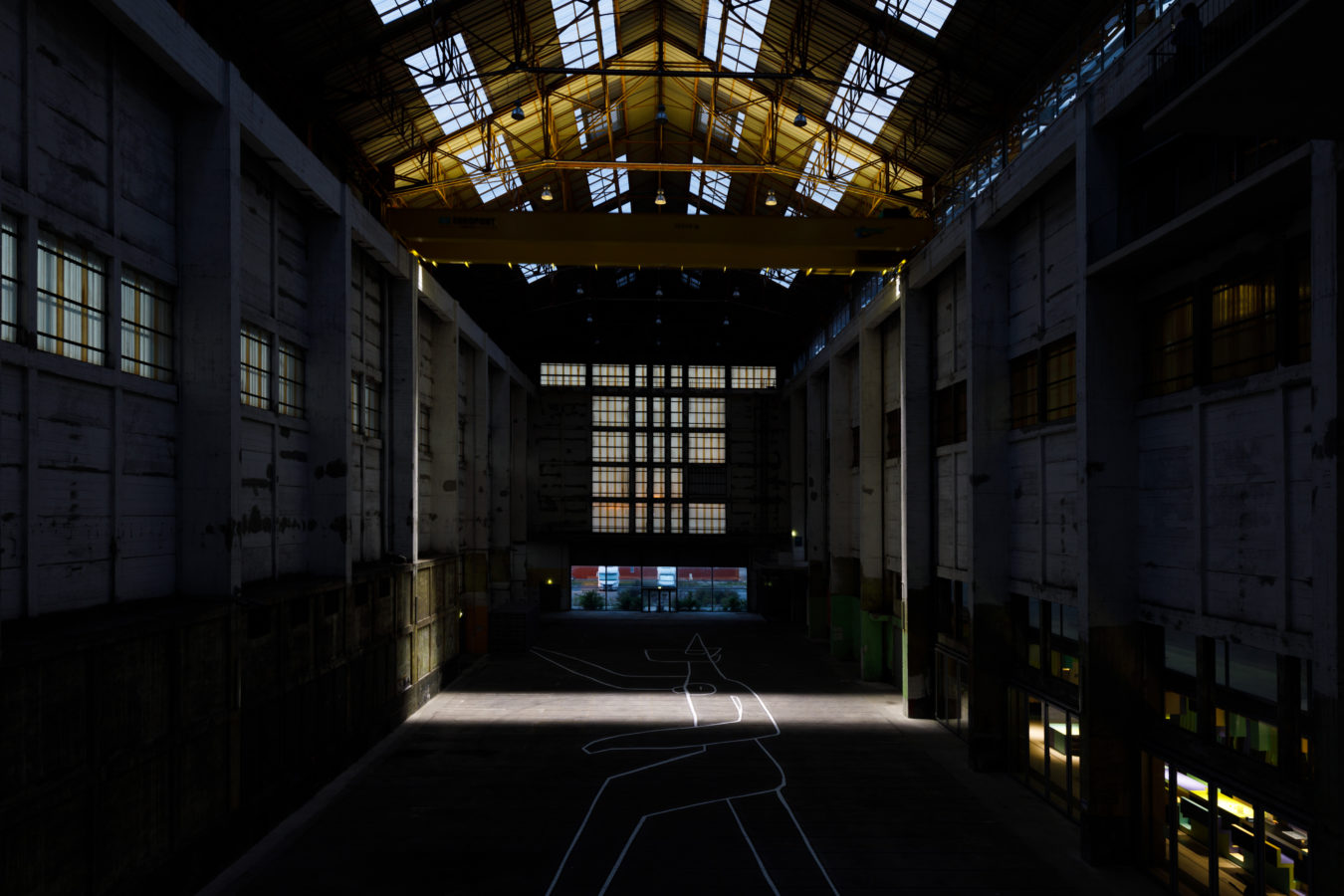
Frac Grand Large — Hauts-de-France collection. Photo : Salim Santa Lucia
The sculptural ensemble by Tatiana Trouvé presents racks of spooled cords, which can be seen as so many Ariadne’s threads to be physically and mentally unwound during one’s strolls about Dunkirk’s labyrinthine urban and port areas – and then wound back up like so many spools of stored memory. These materials linked to the filature and maritime industries evoke virtual extensions towards new destinations and novel crossings, such as those imagined by the artist for New York and other cities.
The very-large-scale texts by Tania Mouraud were imagined for the public sphere: here, a diptych occupying a gable wall in town and two vats situated at the port’s Rubis Terminal, visible both by boat and from the road. The artist has created a poetic “memorial” inspired by Dunkirk’s history. For the port, she has chosen an excerpt from Shakespeare, in English and French; its black lettering and white spacing are stretched to the limits of legibility. “Illegibility transforms this gigantic text into an abstract, geometric décor emphasizing the structure’s architecture. By discovering a reading of the work during one’s trips about town, the stroller is confronted with his or her own desires, while also escaping the inherent solitude of urban life.”
The creations commissioned for GIGANTISME — ART & INDUSTRIE complement an already important ensemble of scattered monumental works by such artists as Bernar Venet and Arman, the earliest of which were installed back in 1980, already thanks to the collaboration of local manufacturers with Dunkirk’s contemporary art museum, today’s LAAC.
This outdoor exhibition also represents an assumed desire to share an open and freely accessible public space, like a revitalizing walk through the heart of town, dotted with encounters, exchanges and meditations, an eminently popular event set between the channel, the canal and the sea…
KD, GG, GL & SW